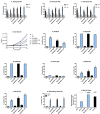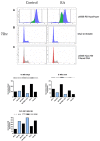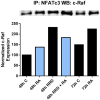RRD-251 enhances all-trans retinoic acid (RA)-induced differentiation of HL-60 myeloblastic leukemia cells
- PMID: 27331409
- PMCID: PMC5216806
- DOI: 10.18632/oncotarget.10136
RRD-251 enhances all-trans retinoic acid (RA)-induced differentiation of HL-60 myeloblastic leukemia cells
Abstract
All-trans-retinoic acid (RA) is known to induce terminal granulocytic differentiation and cell cycle arrest of HL-60 cells. Responding to an RA-induced cytosolic signaling machine, c-Raf translocates to the nucleus, providing propulsion for RA-induced differentiation. This novel mechanism is not understood, but presumably reflects c-Raf binding with nuclear gene regulatory proteins. RRD-251 is a small molecule that prevents the interaction of c-Raf and RB, the retinoblastoma tumor suppressor protein. The involvement of c-Raf and RB in RA-induced differentiation motivates interest in the effects of combined RA and RRD-251 treatment on leukemic cell differentiation. We demonstrate that RRD-251 enhances RA-induced differentiation. Mechanistically, we find that nuclear translocated c-Raf associates with pS608 RB. RA causes loss of pS608 RB, where cells with hypophosphorylated S608 RB are G0/G1 restricted. Corroborating the pS608 RB hypophosphorylation, RB sequestration of E2F increased with concomitant loss of cdc6 expression, which is known to be driven by E2F. Hypophosphorylation of S608 RB releases c-Raf from RB sequestration to bind other nuclear targets. Release of c-Raf from RB sequestration results in enhanced association with GSK-3 which is phosphorylated at its S21/9 inhibitory sites. c-Raf binding to GSK-3 is associated with dissociation of GSK-3 and RARα, thereby relieving RARα of GSK-3 inhibition. RRD-251 amplifies each of these RA-induced events. Consistent with the posited enhancement of RARα transcriptional activity by RRD-251, RRD-251 increases the RARE-driven CD38 expression per cell. The RA/c-Raf/GSK-3/RARα axis emerges as a novel differentiation regulatory mechanism susceptible to RRD-251, suggesting enhancing RA-effects with RRD-251 in therapy.
Keywords: GSK-3; RRD-251; c-Raf; retinoblastoma protein (RB); all-trans retinoic acid (RA).
Conflict of interest statement
None of the authors have competing interests.
Figures









Similar articles
-
Dissecting the novel partners of nuclear c-Raf and its role in all-trans retinoic acid (ATRA)-induced myeloblastic leukemia cells differentiation.Exp Cell Res. 2020 Sep 1;394(1):111989. doi: 10.1016/j.yexcr.2020.111989. Epub 2020 Apr 10. Exp Cell Res. 2020. PMID: 32283065 Free PMC article.
-
The c-Raf modulator RRD-251 enhances nuclear c-Raf/GSK-3/VDR axis signaling and augments 1,25-dihydroxyvitamin D3-induced differentiation of HL-60 myeloblastic leukemia cells.Oncotarget. 2018 Jan 19;9(11):9808-9824. doi: 10.18632/oncotarget.24275. eCollection 2018 Feb 9. Oncotarget. 2018. PMID: 29515772 Free PMC article.
-
Retinoic acid induces expression of SLP-76: expression with c-FMS enhances ERK activation and retinoic acid-induced differentiation/G0 arrest of HL-60 cells.Eur J Cell Biol. 2006 Feb;85(2):117-32. doi: 10.1016/j.ejcb.2005.09.020. Epub 2005 Nov 11. Eur J Cell Biol. 2006. PMID: 16439309
-
Retinoic acid induced mitogen-activated protein (MAP)/extracellular signal-regulated kinase (ERK) kinase-dependent MAP kinase activation needed to elicit HL-60 cell differentiation and growth arrest.Cancer Res. 1998 Jul 15;58(14):3163-72. Cancer Res. 1998. PMID: 9679985
-
Differentiation potential of human retinoblastoma cells.Curr Pharm Biotechnol. 2011 Feb 1;12(2):213-6. doi: 10.2174/138920111794295846. Curr Pharm Biotechnol. 2011. PMID: 21044005 Review.
Cited by
-
Src family kinase inhibitor bosutinib enhances retinoic acid-induced differentiation of HL-60 leukemia cells.Leuk Lymphoma. 2018 Dec;59(12):2941-2951. doi: 10.1080/10428194.2018.1452213. Epub 2018 Mar 23. Leuk Lymphoma. 2018. PMID: 29569971 Free PMC article.
-
Role of Vitamin A/Retinoic Acid in Regulation of Embryonic and Adult Hematopoiesis.Nutrients. 2017 Feb 20;9(2):159. doi: 10.3390/nu9020159. Nutrients. 2017. PMID: 28230720 Free PMC article. Review.
-
An Effective Model of the Retinoic Acid Induced HL-60 Differentiation Program.Sci Rep. 2017 Oct 30;7(1):14327. doi: 10.1038/s41598-017-14523-5. Sci Rep. 2017. PMID: 29085021 Free PMC article.
-
Retinoic acid and 6-formylindolo(3,2-b)carbazole (FICZ) combination therapy reveals putative targets for enhancing response in non-APL AML.Leuk Lymphoma. 2019 Jul;60(7):1697-1708. doi: 10.1080/10428194.2018.1543880. Epub 2018 Dec 20. Leuk Lymphoma. 2019. PMID: 30570341 Free PMC article.
-
Dissecting the novel partners of nuclear c-Raf and its role in all-trans retinoic acid (ATRA)-induced myeloblastic leukemia cells differentiation.Exp Cell Res. 2020 Sep 1;394(1):111989. doi: 10.1016/j.yexcr.2020.111989. Epub 2020 Apr 10. Exp Cell Res. 2020. PMID: 32283065 Free PMC article.
References
MeSH terms
Substances
Grants and funding
LinkOut - more resources
Full Text Sources
Other Literature Sources
Medical
Molecular Biology Databases
Research Materials
Miscellaneous

